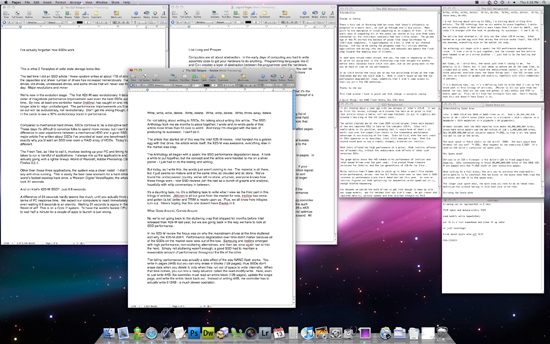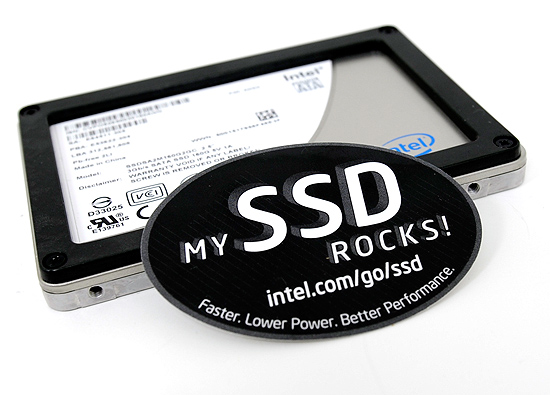Lab Update: The Next SSD Article, Matte vs. Glossy and Touch Screens
by Anand Lal Shimpi on August 21, 2009 4:48 PM EST- Posted in
- Storage
The SSD Relapse
I’ve been teasing everyone on Twitter with this for a while, but I’m really nearing close on the third installment of my SSD coverage. Right now I’m extensively testing TRIM on the major drives. Indilinx is the first out with official TRIM support...at least through a beta firmware. It’s currently enabled on both OCZ and Super Talent drives.

All of the text behind the next SSD article...just wait until you see the Excel sheet to go along with it
There are some limitations to TRIM. Currently the Intel Matrix Storage Manager drivers won’t pass the TRIM command through from Windows 7 to the drive’s controller. If you want TRIM to work at this point you need to use Microsoft’s drivers that come with Windows 7 (note that if you set Intel’s ICH to RAID, Windows 7 loads Intel’s MSM driver so that won’t work).
The benefit of TRIM is huge, your drive doesn’t get slower because of use, it only gets slower as you actually fill it. Intel was very careful/sneaky/shiesty to only enable TRIM on its 34nm drives. Real world performance is actually very similar between the 34nm and 50nm drives for desktop users. What makes the 34nm drive the clear buy is its support for TRIM.

I realize I haven’t said much about the 34nm G2 drives since their announcement, but Intel decided to sample after the announcement so I’ve been busy running these things through the ringer. Intel had to embarrassingly halt shipments of the drive to fix a BIOS password bug that resulted in data loss. I was actually quite surprised that Intel even let this one slip by but they’ve since put tests in place to ensure that it never happens again.
The most impressive advancements really come from the Indilinx camp. Not only has performance improved but Indilinx is actually the first to officially support the ATA8-ACS2 TRIM command. To show you the awesomeness of TRIM I've run a quick test. Here I ran my 4KB Random Write iometer script on a brand new, secure erased Super Talent drive sporting the 1711 TRIM firmware from Indilinx. I then filled the drive (simulating use over time), deleted the partition and benchmarked it again. Note that deleting a partition doesn't seem to trigger TRIM under Windows 7. You'll see that performance drops. Next, I formatted the drive (triggering TRIM) and rebenchmarked:
| SuperTalent UltraDrive GX 1711 | 4KB Random Write IOPS |
| Clean Drive | 13.1 MB/s |
| Used Drive | 6.93 MB/s |
| Used Drive After TRIM | 12.9 MB/s |
Pretty sweet huh? You'd get the same results from the Indilinx Wiper Tool, but this one happens automatically. You get nearly-new performance without doing a thing. TRIM is awesome. The firmware is available from both OCZ and Super Talent but I’d avoid it until it hits final. The Indilinx Wiper Tool is more than sufficient for your TRIMing needs for now.
The WePC Update
I’ve done some writing on a couple of things that have been on my mind lately. The first being Glossy vs. Matte displays on notebooks. It’s something I tackled last year but it’s still a worthwhile topic, especially given the attention Apple is getting. I should mention that Apple has since gone back to offering a Matte display option on its 15-inch MacBook Pros.
The other point of discussion is the future of touch screens outside of smartphones. Apple did a wonderful thing with the iPhone, but now the OEMs are struggling to figure out where touch (and multi-touch) is useful when it comes to notebooks and desktops. Help them figure it out.
Head over to WePC and check it out, leave ASUS/Intel your feedback and you may just see your opinions productized at some point :)
More Ion Cometh
Between the next SSD article and Lynnfield I'll find myself with a bit of time to tackle a look at current (and one upcoming) mini-ITX Ion platforms. My question to you is: is there anything we haven't covered with regards to Ion that you'd like to see in that article?










83 Comments
View All Comments
bobvodka - Friday, August 21, 2009 - link
That really isn't the case here.I'm currently copying my Steam folder (around 100gig) from my F1 spinpoint to a OCZ 250gig SSD. The transfer rate peaked at 90MB/sec during large files and then dropped and held at 75MB/sec when it started copying smaller, fragmented, files and the drive was haing to work harder to seek.
Down to 60MB/sec now for .ogg files and the like with the hard drive working like mad.
As a contrast I've NEVER seen transfer rates that fast with a HDD, even a 10,000RPM drive.
The only 'downside' of SSDs right now is the price:size issue. But the price is dropping as time goes on and early adopters create a bigger market.
My biggest comment when it comes to SSDs is unless you can afford to start replacing HDDs all over the place with them then avoid them, because they really are that impressive when you get used to them.
As a side note, the current BETA Firmware from OCZ (1.42B) does have a couple of issues. While the beta 1.4 is working fine on my laptop, my desktop has had issues with file corruption which have taken a few days to solve. However between the TRIM support and the GC support in the firmware the final release should be pretty sweet when they have ironed out any issue.
MadMan007 - Sunday, August 23, 2009 - link
I hate to burst your bubble but I get nearly those speeds (70+MB/s) even over GigE with the source and destination drives all being WD Caviar Blacks. Maybe I'm misunderstanding what you're saying though.rajaiitm - Friday, August 21, 2009 - link
Hey Anand! you should look at this page .. http://vr-zone.com/articles/ssd-stackup/6842-7.htm...I thought those IOMeter plots were quite informative than just presenting 4KB read/write performance. You should probably have something similar. Its quite interesting to see how different ssds behave differently over the file size range. But I don't know which range is more important and some insight with that would help.
Sandforce! Any info about those guys? News is that they rocked the show at the Flash summit.
P.S. Thanks a ton for the SSD Anthology.
Zorlac - Friday, August 21, 2009 - link
Anand -Are you saying Intel G2 SSD firmware has TRIM enabled already?
And if so, then WTH would Intel not have a MSM driver that supports TRIM? Have they told you when to expect the driver update?
Thanks for keeping us up to date with your findings!! :)
Zorlac
StuR - Tuesday, August 25, 2009 - link
I'm sure you're correct but before spending hundreds of dollars on new SSD's, it would be nice to see all this (TRIM support) in a published Intel document (X-25M G2). I can't find it. Did I miss something?DigitlDrug - Friday, August 21, 2009 - link
Hi Anand,Thanks for your request for input - your thoroughness in researching the underlying technologies of a product is phenomenal.
When discussing the Ion platform can you
1) I think I already know the answer, but it may be helpful for others -> Can you go into detail regarding the implementation for codec acceleration? For example, if H.264 decoding is accelerated, does a specific decode path need to be taken to take advantage of that acceleration? Or is the acceleration performed at the lowest level by the driver, and therefor any player - Media Player, Adobe Falsh (Hulu), etc. - automatically takes advantage of the acceleration.
2) What level of linux support are we currently seeing with Ion re. Video acceleration? (pertinent when using an HTPC linux distribution). Has NVidia devulged plans for future driver support. Obviously they would never say "Linux Who?" but maybe you have a helpful contact . . . . ; >)
3) Is the accelerated decode pipeline flexible enough to handle future codecs, and are they likely to be supported via the Unified Driver model? Obviously the atom lacks the horse power to handle decode on the latest codecs, so mpc users looking for "Relatively" future proof players would be relying heavily on the Ion to pickup the slack.
Re. SSD's - can you include a discussion on the lower end Indilinx models from OCZ? They appear to be introducing different flavors of drive based on the controller, and all reviews thus far have looked at differences in speed, etc. I'm curious to know if they are also using different versions of the controller (in features), and any gotchas beyond speed (future firmware/feature support, longevity). Where is the cost savings coming from?
Thanks again for all the great work.
- Jordan
Pandamonium - Saturday, August 22, 2009 - link
I'm still very interested in the Ion coverage. I think Tweaktown or somebody had a rough review of the ASRock BD-330. They claimed to get a stable overclock that was a bit higher than what Anand was able to get out of the Zotac, and IIRC, the GPU clock was slightly higher. Since it looks like the Zotac ION-A can't handle Hulu, I was wondering if ASRock's implementation fared any better. As far as I can tell, the options for a small and relatively cool-running HTPC are an Ion system (might be too slow), a Dell Studio Hybrid (still uses GMA), or a Mac Mini (lacks blu-ray option).As far as SSDs, I'd like to see some data on the X18-M or other 1.8" SSDs. I suspect performance is comparable to the X25-M, but I wanted to know the battery life impact of upgrading from a 1.8" HDD to a 1.8" SSD. From what I've read, Intel has some enhanced firmware that reduces power consumption whereas the other manufacturers do not. I'll probably end up with an X18-M G2 anyway, but I'd like the data if it's available. (My XT2 only takes 1.8" drives)
chemist1 - Friday, August 21, 2009 - link
Also, for those of us with slightly older Core 2 Duo macs (e.g., my early 2008 MBP), which are limited to 150 MB/s for the SATA interface, is their any *practical* lessening in performance (vs. w/ a 300 MB/s interface)? It's possible there is not since, as you've pointed out, it's 4K random reads and writes that are important, and these are <150MB/s with current SSDs. [Alternately, do you know if a firmware adjustment might be able to bring those pre-2009 macs up to 300 MB/s? The Intel ICH8-M AHCI chipset used for the SATA interface on my MBP is, I think, in principle, able to handle 300 MB/s.]Anand Lal Shimpi - Saturday, August 22, 2009 - link
Nearly every single drive I've tested can read at 250 - 260MB/s. You would theoretically lose some read/copy performance there. If Apple hasn't enabled it yet, I don't think there's any hope for Apple enabling it in the future.That being said, even limited to 150MB/s, you're still *far* better off with a good SSD than with a hard drive. Especially a 2.5" notebook hard drive.
Buy an Indilinx or Intel SSD. Try it for a week, then switch back to your old hard drive. You'll forget all about the 150MB/s limit and be begging to put the SSD back in :)
Take care,
Anand
chemist1 - Friday, August 21, 2009 - link
Anand, do you know if trim will be supported in snow leopard?